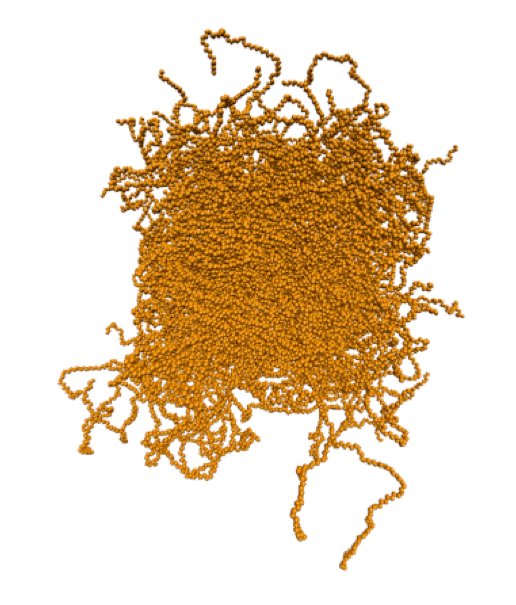WELCOME to The Guenza Lab webpages
Recent technological innovations in biology, material science, and information science are bringing about the potential to organize, understand, and formalize the most recent experimental results in term of well-defined theoretical approaches. Our contribution in this area is the development of theoretical frameworks that elucidate physical processes in complex systems on the basis of their underlying molecular structure. We combine simulations and analytical theory in an effort to overcome long-standing problems in complex fluids.
In particular, we have developed theories for the coarse-grained structure, thermodynamics, and dynamics of synthetic polymer systems, and biological macromolecules. The structure and dynamics of complex macromolecular fluids are characterized by an extended range of length scales and time scales in which relevant phenomena take place. Because of the limitations of simulations, reduced representations of a system are needed in order to speed up the computation to access the properties of interest. The goal of our research is the design and implementation of theoretical approaches that coarse-grain structure and dynamics of molecular liquids. Our theoretical models are based on statistical mechanics and liquid state theory, and are applied to study a number of key systems and related questions in material science and biophysics.
COARSE-GRAINING MACROMOLECULAR LIQUIDS WITH INTEGRAL EQUATION THEORY:
In complex liquids, relevant properties interest length scales from the atomistic to the macroscopic, with phenomena that involve phase separation, de-mixing, self-assembly, and more. Understanding the physics of these phenomena is important but also a real challenge: reliable coarse-grained representations are needed to address the relationship between molecular structure and multi-scale properties at the selected thermodynamic conditions.
The Integral Equation Coarse-Grained (IECG) codes are available to download at the dedicated website

COARSE-GRAINED DYNAMICS OF PROTEINS OR THE LANGEVIN EQUATION FOR PROTEIN DYNAMICS:
Key biochemical processes, such as DNA replication, transcription, and repair, are initiated by molecular recognition events that involve binding of proteins to other proteins and to the DNA substrate. For example, in DNA replication, multiple proteins self-assemble and bind DNA to form the replication complex, in a process that occur through multiple steps that are mostly unknown. Molecular fluctuations play a key role in these processes, not only by defining the extent of the configurational phase space, and thus the change in entropy of the system upon binding, but also by defining a possible kinetic pathway for the binding reaction. Because dynamics takes place on multiple time scales, computational models need to be developed that model large scale fluctuations as a function of the atomistic molecular properties. However, molecular dynamics simulations, which are the method of choice for these studies, at atomistic resolutions cannot reach the experimental long timescale of interest for large-size complexes. Therefore, the use of reduced descriptions, or coarse-grained models, is much needed in the studies of the mechanism and kinetics of complex formation. We have developed a CG model for protein dynamics that is accurate and analytically solved, called the Langevin Equation for Protein Dynamics or LE4PD. This model has been successfully applied to the study of fluctuation and binding of a number of proteins.
RECENT PUBLICATIONS:
E. R. Beyerle, M. Dinpajoon, H. Ji, P. H. von Hippel, A. H. Marcus, and M. G. Guenza Dinucleotides as simple models of the base stacking-unstacking component of DNA ‘breathing’ mechanisms Nucleic Acid Research 1-14, (2021). DOI: 10.1093/nar/gkab015.
E. Beyerle and M. G. Guenza, “Kinetic Analysis of Ubiquitin Local Fluctuations with Markov State Modeling of the LE4PD Normal Modes” The Journal of Chemical Physics, 151, 164119(1-13) (2019) DOI:10.1063/1.5123513.
M. Dinpajooh and M. G. Guenza, “Can Pure Polymer Liquids Be Represented at Two Different Resolutions Simultaneously?” The Journal of Chemical Physics Communication, 151, 061102(1-5) (2019) DOI:10.1063/1.5115791.
M. G. Guenza, M. Dinpajooh, J. McCarty, I. Y. Lyubimov “Accuracy, Transferability, and Efficiency of Coarse-Grained Models of Molecular Liquids” The Journal of Physical Chemistry B, 122(45), 10257-10278 (2018). DOI: 10.1021/acs.jpcb.8b06687. Publication Selected as Editor’s Pick and Feature Article.
M. Dinpajooh, M. G. Guenza “Coarse-graining simulation approaches for polymer melts: the effect of potential range on computational efficiency” Soft Matter, 14, 7126-7144 (2018). Cover paper.
M. Dinpajooh, and M. G. Guenza “On the Density Dependence of the Integral Equation Coarse-Graining Effective Potential” The Journal of Physical Chemistry B, 122(13), 3426-3440 (2018). DOI:10.1021/acs.jpcb.7b10494.
Our research is supported in many ways by the National Science Foundation through the Chemistry Division (Theoretical Chemistry), the Division of Physics (Condensed Matter: Material Theory), and the computational effort is supported by the XSEDE program of NSF.
Our research has also been supported by the Petroleum Research Fund of the American Chemical Society and the University of Oregon.
